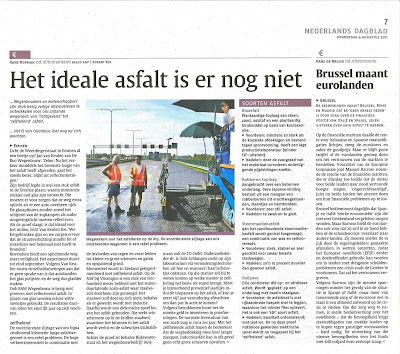We are proud to announce that we also created a BLOG for Self Healing Concrete.
If you want to find out more, have a look at:
http://www.selfhealingconcrete.blogspot.com/
Self Healing Aspalt on the A58
On this Blog we will give info on the test track with Self Healing Asphalt that is built on the A58 near Vlissingen in The Netherlands. The Asphalt is a special type of ZOAB (very porous aphalt concrete) containing small steelwool fibres. A known but serious problem with ZOAB is ravelling: stones at the surface coming off in time due to microcracking in the binder. The special ZOAB that is developed at Delft University (sponsored by AgentschapNL) can be heated with induction energy due to the fibres that are present which closes the microcracks and with that extends the service life of the road.
Sunday, 14 August 2011
Tuesday, 9 August 2011
2nd edition of Self Healing Materials brochure
AgentschapNL published a new version of the Self Healing Materials booklet. You can download it by clicking on the image. Happy reading!
test results look promising....
Of course you are all waiting to see some results of the laboratory tests that are now being performed on the samples that we took from the road. We do not have final conclusions yet, however, tests show that the service life of the material might increase (a lot).
The results shown below are from the 4-point bending fatigue tests performed in the road engineering lab at Delft Univerity. In this set-up different type of tests are compared.
 The first line in the graph at the right is for the reduction in flexural sifttness in the original fatigue test. The next line is if we repeat the fatigue test after a rest period of 18 hours. The third line is for the case if we apply heating to 70 C during the rest period. The heating realy improves the behaviour of the material
The first line in the graph at the right is for the reduction in flexural sifttness in the original fatigue test. The next line is if we repeat the fatigue test after a rest period of 18 hours. The third line is for the case if we apply heating to 70 C during the rest period. The heating realy improves the behaviour of the material
In the figure at the right it can be seen that we did do multiple loading cycles where we had rest periods including heating. The material almost recovers completely after each cycle and the total fatigue loading cycles that can be done is much much larger than the test without resting and heating.
Please don't get too exited....We should not conclude yet from this result that the service life of the road will increase in the same manner, however, it looks promissing, doesn't it?
The results shown below are from the 4-point bending fatigue tests performed in the road engineering lab at Delft Univerity. In this set-up different type of tests are compared.
 The first line in the graph at the right is for the reduction in flexural sifttness in the original fatigue test. The next line is if we repeat the fatigue test after a rest period of 18 hours. The third line is for the case if we apply heating to 70 C during the rest period. The heating realy improves the behaviour of the material
The first line in the graph at the right is for the reduction in flexural sifttness in the original fatigue test. The next line is if we repeat the fatigue test after a rest period of 18 hours. The third line is for the case if we apply heating to 70 C during the rest period. The heating realy improves the behaviour of the materialIn the figure at the right it can be seen that we did do multiple loading cycles where we had rest periods including heating. The material almost recovers completely after each cycle and the total fatigue loading cycles that can be done is much much larger than the test without resting and heating.
Please don't get too exited....We should not conclude yet from this result that the service life of the road will increase in the same manner, however, it looks promissing, doesn't it?
article on project in Nederlands Dagblad
On August 4 the Nederlands Dagblad published an article in Dutch with the title
"The ideal asphalt does not exist yet" (but we are getting close....).
"The ideal asphalt does not exist yet" (but we are getting close....).
Monday, 8 August 2011
self healing conference ... continued
The extended abstract of the presentation can be downloaded here: Schlangen_Extended_Abstract_BATH
and the powerpoint slides of the presentation can be found here: Schlangen_Presentation_Bath
and the powerpoint slides of the presentation can be found here: Schlangen_Presentation_Bath
Self Healing Conference Bath
End of June we had a very interesting conference in Bath UK about self healing materials.
A lot of new research was presented and many good ideas for furthure work were proposed.
Below you see all the participants:
Erik presented the work on the self healing road. It turned out that this was one of the first real application (and maybe the only one...) of a civil engineering self healing material.
A lot of new research was presented and many good ideas for furthure work were proposed.
Below you see all the participants:
Erik presented the work on the self healing road. It turned out that this was one of the first real application (and maybe the only one...) of a civil engineering self healing material.
Subscribe to:
Posts (Atom)







